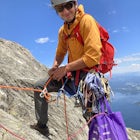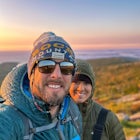Photograph Moose in Rocky Mountain National Park
Grand Lake, Colorado
Description
Added by Tsalani Lassiter
The westside of Rocky Mountain National Park if a beautiful riparian valley with awesome mountain views. It is also a great place to see Moose.
Moose are the largest members of the deer family. They can stand over 6ft tall at their shoulders and weigh over 1500lbs. Males have antlers which can reach 6ft across and weigh up to 40lbs each. Amazingly these impressive creatures are strictly herbivores and will eat several dozen pounds of vegetation per day.
Viewing Area -
At Rocky Mountain National Park, you will have the most success on the west side of the park near the entrance. In fact, you may have already seen a few along the river or ponds on your way into the park. Moose prefer to stay near water where there are willows and aquatic plants. They typically establish a feeding ground and depending on food availability, they will remain in the same area for days or even weeks. The most consistent viewing windows are during dawn and dusk. Moose can usually be seen around sunrise and sunset, give or take an hour or so. As the sun rises they will often seek shade and can be found laying in brush or under trees. Once this happens they are much harder to spot.
From the west entrance head north/east along highway 34. Moose viewings will really heat up about 6.5 miles in at the coyote valley trailhead.
- If you want to stay in your car keep an eye out for moose along the rivers and ponds. Take each pull out and scan the meadow for large dark shapes. Continue along highway 34 for 3 miles to two more great viewing areas, the beaver ponds and beaver creek picnic area.
- If you are up for a hike any hike try the Colorado River or Red Mtn Trails. They both follow water closely and are great areas to spot moose.
What you need -
When on any wildlife sighting adventure, for your safety as well as the animals you should keep your distance. If you want to get a good photo be sure to bring a DSLR / mirrorless camera and a telephoto lens (70-200, 100-400mm, 600mm). You should use a tripod to keep your shots steady. If you get lucky you'll be shooting quite a few shots so make sure to have extra memory cards and batteries.
*Note: Moose may seem sluggish and stagnant, but they are actually very fast. They can easily reach speeds of 30-35 mph over a variety of terrain. Moose are wild animals and have been known to be aggressive and charge people who get too close. Be extra careful around a moose with a calf, as they are extremely protective of their young ones.
Download the Outbound mobile app
Find adventures and camping on the go, share photos, use GPX tracks, and download maps for offline use.
Get the appFeatures
Photograph Moose in Rocky Mountain National Park Reviews
I have seen three moose in Rocky two of which were on the west side which is where I am told is the best place to find them if you look around dusk or so.
5.0
Sprague Lake is the best place at sunrise and sunset to see the parks moose. Easy parking, and a flat trail make it ideal for photographers along the lake shore. Several bulls and mothers and babies frequent this area to eat at the beginning and end of the day.
5.0
This is SO true, and a great capture of the funky animals that moose are. I used to watch people try to photograph the moose near to Buckaroo Barn on the west side and they SO frequently would end up agitating the moose and sometimes getting little charges out of them. Not worth the photo. Be conscious of the habitat they're in, whether there are babies nearby, etc
3.0
Leave No Trace
Always practice Leave No Trace ethics on your adventures and follow local regulations. Please explore responsibly!
Nearby
Car Camp at Timber Creek Campground
Hike to Timber Lake
Hike the Colorado River Trailhead Loop
Backpack Alpine Terrain to Haynach Lakes
Mt. Ida via Milner Pass
Hike to Big Meadows and Granite Falls
Community
© 2024 The Outbound Collective - Terms of Use - Privacy Policy











